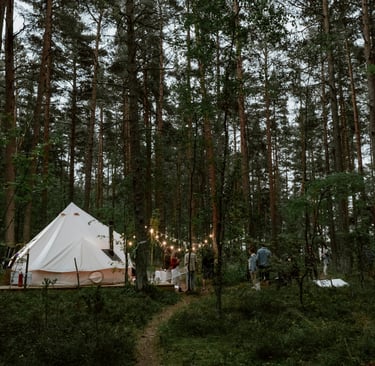The Power of Storytelling in Your Glamping Business (And How to Do It Right)


The Power of Storytelling in Your Glamping Business (And How to Do It Right)
Forget “just the facts.”
In the glamping world, story sells.
Your tent might be stunning.
Your view might be breathtaking.
But if your brand voice feels flat, forgettable, or just like everyone else’s—you’re leaving bookings (and money) on the table.
The good news? You don’t need a marketing degree to tell stories that convert. You just need to be real, clear, and emotionally smart.
Let’s break down why storytelling works—and how to use it to turn scrollers into bookers.
Why Storytelling Works in Glamping
Glamping is an emotional decision.
People aren’t booking a bed—they’re booking:
A vibe
A reset
A celebration
A memory
A feeling
Storytelling bridges the gap between what you offer and what they’re craving.
The right story makes someone say, “Yes. That’s exactly what I need right now.”
Where to Use Storytelling
You don’t have to write a novel. Just weave storytelling into key places:
Your website “About” page
Your listing description
Your Instagram captions
Your booking confirmation email
Your guest welcome book
Each moment is a chance to build connection.
How to Tell Your Glamping Story (The Right Way)
Here’s the framework I teach all my glamp-hosts:
1. Start With the Why
People connect with purpose more than features.
Why did you choose this land?
What made you build this way?
What do you want guests to feel?
Example:
“We left the city to create a space where people could finally breathe. Every detail—from the wood-fired hot tub to the stargazing deck—was built to slow you down.”
2. Zoom In on Real Moments
Don’t just list amenities. Paint a picture.
What does sunrise look like from the deck?
What does it feel like to read by the firelight?
What kind of conversations happen under the stars?
Example:
“You’ll wake to birdsong, sip your coffee with mountain views, and end your night wrapped in blankets beside a crackling fire.”
3. Use Guest Language
The best copy? Comes from real reviews.
Pull actual phrases from past guests
Use their language to describe the experience
Reflect back what they loved most
Example:
“One guest called it ‘our reset button in the wild’—and we couldn’t agree more.”
4. Create an Arc: Before → During → After
Structure your storytelling like a journey.
Before: Guest is stressed, stuck, screen-tired
During: They unplug, reconnect, breathe deeper
After: They feel lighter, clearer, present
Example:
“You arrive wound up. You leave wondering why you ever stopped listening to the wind in the trees.”
5. Invite the Reader In
Use “you” more than “we.”
Let them see themselves in the story.
Example:
“This isn’t just a glamping site. It’s your chance to pause, recharge, and remember what matters most.”
Bonus: 3 Types of Stories That Sell
Guest Moments
Turn a past guest’s story into a post or feature.
Behind the Build
Share what inspired your setup, your land, or your design.
Tiny Transformation
Show how even a 2-night stay created big shifts in someone’s energy or mindset.
Final Takeaway
Your glamping business isn’t just made of wood, canvas, and hot tubs.
It’s made of stories.
Tell them well—and they’ll sell your brand for you.
Because people don’t book a place. They book a promise.
And storytelling is how you deliver it before they ever arrive.
